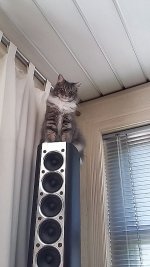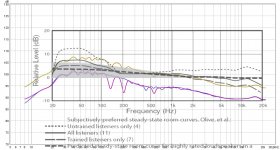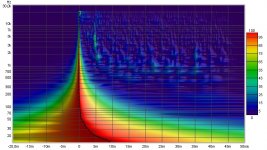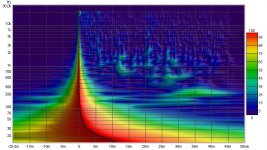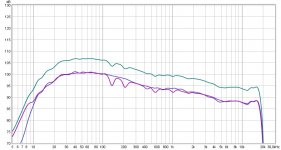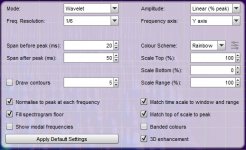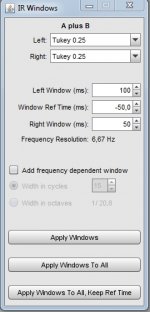I wonder if it is possible to take the .wav file generated by Audiolens and play it in Jriver through the Par-eq and mid/side eq and then record the result and make it the new convolver .wav file?
I would then use HQpalyer only with the new convolver .wav file.
If this can be done, it could perhaps lighten the burden for the CPU while playing back ?
I would then use HQpalyer only with the new convolver .wav file.
If this can be done, it could perhaps lighten the burden for the CPU while playing back ?
Sorry, I believe that would be a no go. The mid/side EQ runs actively while playing a song, you'd be feeding it a Stereo wave file and it would ruin what it's supposed to do. That's why I warned that mid/side EQ should really be done before anything else.
Even a Dirac pulse run trough the JRiver DSP would only show the mid part of mid/side EQ, as both channels would be exactly the same. It is when the side info is different from left to right that this part gets altered. Like in a regular Stereo song.
The only thing you can do is convert a couple of songs trough mid/side EQ.
You can create a total correction file by running a dirac pulse trough JRiver and record it to disk, but this should not include the mid/side EQ part.
I use the "Disk Writer" option for many tests. I feed it with a Dirac pulse to see total correction. I feed it with the recorded measurement to find out the predicted wave shape. I feed it with a Stereo file to look at my "mid" part of EQ and with a left only with empty right track to see the side EQ etc.
It takes some experimenting but it is a very useful tool to know/learn what you're doing.
In a standard Windows install JRiver stores the result in the "music" library in a JRiver folder.
Even a Dirac pulse run trough the JRiver DSP would only show the mid part of mid/side EQ, as both channels would be exactly the same. It is when the side info is different from left to right that this part gets altered. Like in a regular Stereo song.
The only thing you can do is convert a couple of songs trough mid/side EQ.
You can create a total correction file by running a dirac pulse trough JRiver and record it to disk, but this should not include the mid/side EQ part.
I use the "Disk Writer" option for many tests. I feed it with a Dirac pulse to see total correction. I feed it with the recorded measurement to find out the predicted wave shape. I feed it with a Stereo file to look at my "mid" part of EQ and with a left only with empty right track to see the side EQ etc.
It takes some experimenting but it is a very useful tool to know/learn what you're doing.
In a standard Windows install JRiver stores the result in the "music" library in a JRiver folder.
Last edited:
I may have been posting a bit less than usual but I was busy trying something different processing wise. From start to finish it always took me an insane amount of time to achieve what I wanted.
I figured there should be an easier way and I seem to have found one. I'm actually using a 2 step DRC processing and follow up with REW/RePhase.
I've done a couple of different ways to get the hang of it and learn the inns and outs and am pretty pleased with the end results so far.
It takes way less time from measurement to listening which is what I had in mind. Way less steps than what I've used before. The end result is even cleaner than the old ways I used before.
What I do is go from measurement to DRC correction. Next I make a prediction of that result by running it trough JRiver + convolution. The result of that gets one more go trough DRC and is aimed for flat response.
Next I work out the shape of target I want to end up with, plus a couple of EQ tweaks based on a longer window (as the window set for processing is quite small, mostly less than 6 cycles worth) to have it correspond with the tonal perception I hear.
From time to time I've had a little help(er):
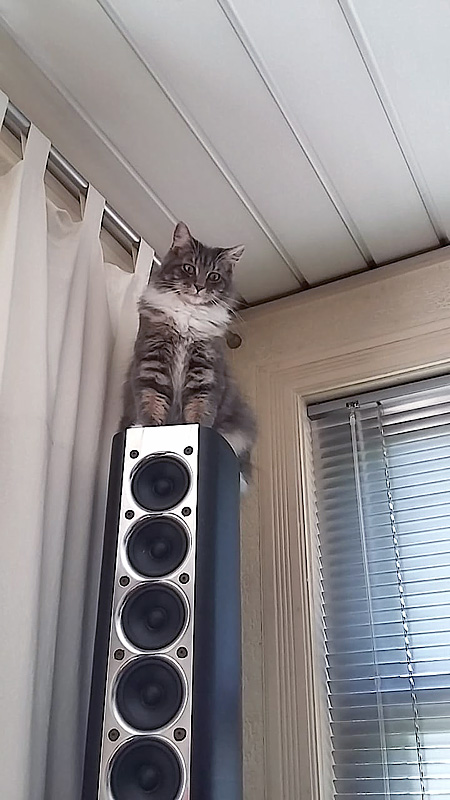
This type of processing has got me cleaner results and particularly important to mention also less pré-ringing. I did have to tweak my template a bit and even though I do run 2 stages of processing, the variables differ slightly between the steps. One is meant to combat phase anomalies in the lower registries while the other step is there to prevent ringing as well as get a better (more flat) correction.
This saves me tons of work!
Anyway, for those that haven't played with target curves, please do! You're missing out if you don't do it. I went from: hey, that sounds cool to Oh my god! All of that in a couple of tries! I should mention this was with the mid/side EQ based on the latest measurements with the foam ball. The correction was made with those measurements as well.
I figured there should be an easier way and I seem to have found one. I'm actually using a 2 step DRC processing and follow up with REW/RePhase.
I've done a couple of different ways to get the hang of it and learn the inns and outs and am pretty pleased with the end results so far.
It takes way less time from measurement to listening which is what I had in mind. Way less steps than what I've used before. The end result is even cleaner than the old ways I used before.
What I do is go from measurement to DRC correction. Next I make a prediction of that result by running it trough JRiver + convolution. The result of that gets one more go trough DRC and is aimed for flat response.
Next I work out the shape of target I want to end up with, plus a couple of EQ tweaks based on a longer window (as the window set for processing is quite small, mostly less than 6 cycles worth) to have it correspond with the tonal perception I hear.
From time to time I've had a little help(er):
This type of processing has got me cleaner results and particularly important to mention also less pré-ringing. I did have to tweak my template a bit and even though I do run 2 stages of processing, the variables differ slightly between the steps. One is meant to combat phase anomalies in the lower registries while the other step is there to prevent ringing as well as get a better (more flat) correction.
This saves me tons of work!
Anyway, for those that haven't played with target curves, please do! You're missing out if you don't do it. I went from: hey, that sounds cool to Oh my god! All of that in a couple of tries! I should mention this was with the mid/side EQ based on the latest measurements with the foam ball. The correction was made with those measurements as well.
Attachments
...From time to time I've had a little help(er)...
All Along The Watchtower ...
While there are slight differences, I'm still quite close to the JBL curves (I guess I like a little more bass)

Plots of left, right and their sum, gate set at 25 ms and smoothed with Var smoothing.
The left and right timing in charts:
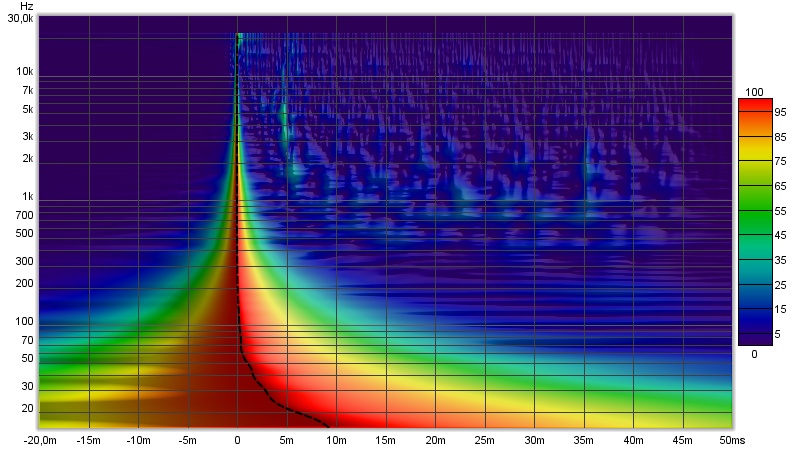
Left side
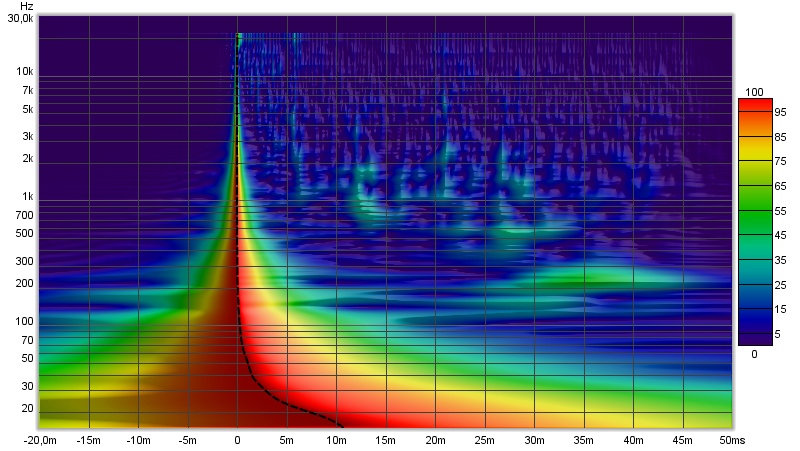
Right side
Plots of left, right and their sum, gate set at 25 ms and smoothed with Var smoothing.
The left and right timing in charts:
Left side
Right side
Attachments
And here is a 6-cycle window in REW:

Which makes it more obvious that I use the longer (gated) window to adjust left/right (tonal) balance and use DRC primarily to get the best early wave front I can get. Without going overboard trying to fix nulls (which should be fixed in the room). Easy to spot the right side still has some room effects that mess with it, sadly no more damping panels for me or I'd get in deep trouble. Hopefully the subs let me fix some of that.
New for me is the tilt upwards at the high end, it does seem to bring something without being obvious.
From the SPL figures it should be obvious these are predictions made with JRiver + convolution, feeding it the "as measured" IR. It is much harder to setup the foam ball with microphone in the exact same spot each time, I'd only dare to try that if I had more time to play. These graphs represent the left and right ear position, not the "exact sweet spot" like previous measurements I've shown.
Which makes it more obvious that I use the longer (gated) window to adjust left/right (tonal) balance and use DRC primarily to get the best early wave front I can get. Without going overboard trying to fix nulls (which should be fixed in the room). Easy to spot the right side still has some room effects that mess with it, sadly no more damping panels for me or I'd get in deep trouble. Hopefully the subs let me fix some of that.
New for me is the tilt upwards at the high end, it does seem to bring something without being obvious.
From the SPL figures it should be obvious these are predictions made with JRiver + convolution, feeding it the "as measured" IR. It is much harder to setup the foam ball with microphone in the exact same spot each time, I'd only dare to try that if I had more time to play. These graphs represent the left and right ear position, not the "exact sweet spot" like previous measurements I've shown.
Attachments
Last edited:
are those REW spectrograms back in post 5008? If so, what were the controls?
My spectrogram is nothing like those, although it looks better with shorter windows. I've got echos coming full spectrum for 300ms and past the 1sec window REW looks over down low. (I think you already pointed that out)
I just found a source for 3" thick foam panels that can be glued to walls and garage door; haven't seen pricing yet.
My spectrogram is nothing like those, although it looks better with shorter windows. I've got echos coming full spectrum for 300ms and past the 1sec window REW looks over down low. (I think you already pointed that out)
I just found a source for 3" thick foam panels that can be glued to walls and garage door; haven't seen pricing yet.
Yes they are. These are plots that resemble the way APL_TDA shows it's plots. I've nagged John about it for a long time and at a certain point he caved in and just included it (*). I find them handy to view the timing. I'll show the parameters I've used:
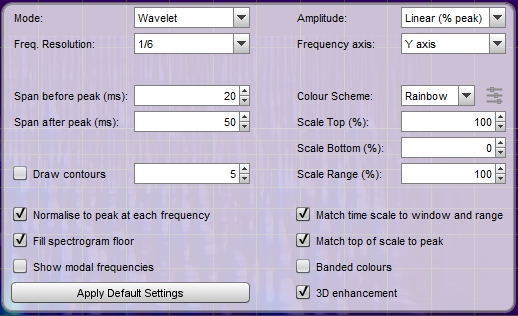
As said, primary use is timing, nothing more, nothing less but it does show pré ringing and the room as well, be it that the focus lies on the peak.
Very comparable to/compattable with APL_TDA's way of showing the timing.
The plot a few pages back with a comparison between a Danley horn and the array were not done with these numbers! No normalising was used for that one and it showed SPL in dB, not in percentage. So that's using these wavelets for quite a different goal.
(*) In all honesty I can't even say if I played any role in his choice to add this feature but I did ask and discuss this feature with him a couple of times.
In this thread he showed early results which developed into that neat feature.
As said, primary use is timing, nothing more, nothing less but it does show pré ringing and the room as well, be it that the focus lies on the peak.
Very comparable to/compattable with APL_TDA's way of showing the timing.
The plot a few pages back with a comparison between a Danley horn and the array were not done with these numbers! No normalising was used for that one and it showed SPL in dB, not in percentage. So that's using these wavelets for quite a different goal.
(*) In all honesty I can't even say if I played any role in his choice to add this feature but I did ask and discuss this feature with him a couple of times.
In this thread he showed early results which developed into that neat feature.
Attachments
Last edited:
thanks. now it looks familiar, for a chuckle, look at my last post
https://www.diyaudio.com/forums/full-range/337956-range-line-array-wall-corner-placement-17.html#post5824124
https://www.diyaudio.com/forums/full-range/337956-range-line-array-wall-corner-placement-17.html#post5824124
Different graphs for different tasks  . Looks like you'll be busy with some room adjustments. Some DRC tweaking may go a long way though. Your room is still adding energy, but it is quite even in balance (aside from the 200 Hz mode).
. Looks like you'll be busy with some room adjustments. Some DRC tweaking may go a long way though. Your room is still adding energy, but it is quite even in balance (aside from the 200 Hz mode).
Does it (the dip) stay at the same spot if you move the array further from the back wall?
I used to go over the Fourier spectrograms while slowly increasing time to get a feel for what was happening out in the room, wavelets weren't introduced back then.
Does it (the dip) stay at the same spot if you move the array further from the back wall?
I used to go over the Fourier spectrograms while slowly increasing time to get a feel for what was happening out in the room, wavelets weren't introduced back then.
It would certainly back down in areas where there's excess energy. It also skips the deep nulls from processing. As it should. The better the room conditions, the better the correction will look. While the frequency dependent views are excellent to see the first wave front, adjusting tonality needs slightly longer windows. Usually the room fills in the small stuff pretty well, see the predictions posted on your thread.
I'm quite happy with this new form of processing. I think it's time to move on to finishing the subs. Who knows, this might increase the performance if I get it all to play well together.
The openness, dynamics and imaging as well as great tonality are all there. I think/believe the mid/side EQ is all that one needs to counter the Stereo cross talk after all. So no more crazy experiments for a while, this is the third time that mid/side EQ won the battle for me.
The measurements with the foam ball helped a lot, I'm glad I did those. While there may still be some finesse's to fine tune, this is the closest I've come to be able to incorporate all that I like into one mix of DSP.
Over the coming days I'll try and upgrade the HT mode too. That one still uses the old files and a shuffler. Not bad at all, but not as good as this new EQ scheme, derived from the foam ball measurements.
Due to busy schedules at work I've put off finishing the sub-woofers. So I hope to find the energy and time to get started in the coming weeks. I still need to order a few parts and then nothing stands in the way of getting it done.
The openness, dynamics and imaging as well as great tonality are all there. I think/believe the mid/side EQ is all that one needs to counter the Stereo cross talk after all. So no more crazy experiments for a while, this is the third time that mid/side EQ won the battle for me.
The measurements with the foam ball helped a lot, I'm glad I did those. While there may still be some finesse's to fine tune, this is the closest I've come to be able to incorporate all that I like into one mix of DSP.
Over the coming days I'll try and upgrade the HT mode too. That one still uses the old files and a shuffler. Not bad at all, but not as good as this new EQ scheme, derived from the foam ball measurements.
Due to busy schedules at work I've put off finishing the sub-woofers. So I hope to find the energy and time to get started in the coming weeks. I still need to order a few parts and then nothing stands in the way of getting it done.
More listening, still pleased. Experimented with a linear phase target file vs minimum phase. Only slight differences in the plots, but I do have a favorite.
FR looks identical with 6 cycle or 25 ms gated and smoothed. It's the phase and thus the timing that differs. Even un-smoothed they are hard to tell apart.
I may have some ideas on improvement, time will tell...
For anyone interested on what they get pré peak or in other words: pré-ringing: Use REW's IR windows with these values:

If you don't use any smoothing, it will show what happens before that first peak. Sort of a sanity check for those manipulating phase.
Or linearising crossovers for that matter...
FR looks identical with 6 cycle or 25 ms gated and smoothed. It's the phase and thus the timing that differs. Even un-smoothed they are hard to tell apart.
I may have some ideas on improvement, time will tell...
For anyone interested on what they get pré peak or in other words: pré-ringing: Use REW's IR windows with these values:
If you don't use any smoothing, it will show what happens before that first peak. Sort of a sanity check for those manipulating phase.
Or linearising crossovers for that matter...
Attachments
Last edited:
Still working on the mid/side EQ. Tricky business... if one makes the difference between mid and side larger, you actually reduce the dynamic range you have.
This is because the two are interlinked, no way around that.
A little goes a long way though. Still playing with it to hear what it does. Too aggressive settings eats up little details, but we might not need aggressive at all. It works wonders for the phantom part, it can make improvements for the tonal balance between center and sides but as said... it is a thin line.
- A boost of the side introduces an inverse signal in the opposite channel. As demonstrated before on this thread.
- A boost on the phantom mid also creates a boost of side panned material (also noted previously on this thread).
So why bother with it at all? Because of what it does for the phantom center as well as tonal balance. Get it right and you get a 3D holographic stage that is quite convincing.
Slowly but surely I'm trying to learn all of the inns and outs. Trying hard to remember my previous experiences and creating new ones. Right now I'm on a small break, the Dutch TT is coming up again. So my little town is turning into a sweet spot of festivities again .
.
This is because the two are interlinked, no way around that.
A little goes a long way though. Still playing with it to hear what it does. Too aggressive settings eats up little details, but we might not need aggressive at all. It works wonders for the phantom part, it can make improvements for the tonal balance between center and sides but as said... it is a thin line.
- A boost of the side introduces an inverse signal in the opposite channel. As demonstrated before on this thread.
- A boost on the phantom mid also creates a boost of side panned material (also noted previously on this thread).
So why bother with it at all? Because of what it does for the phantom center as well as tonal balance. Get it right and you get a 3D holographic stage that is quite convincing.
Slowly but surely I'm trying to learn all of the inns and outs. Trying hard to remember my previous experiences and creating new ones. Right now I'm on a small break, the Dutch TT is coming up again. So my little town is turning into a sweet spot of festivities again
...Right now I'm on a small break, the Dutch TT is coming up again. So my little town is turning into a sweet spot of festivities again.
Whatever is planned or happens have a best break or party
I survived another TT-week here and I am back at it...
The mid/side tweaks remain a delicate matter. I do believe I'm making progress, though my listening time today got cut short.
I'm trying to learn what to compensate for and how to do it. Earlier I stated the mid/side might have to be minimum phase EQ, well, scrap that. It simply doesn't work, as the side info gets melted together too much and you end up with a sort of mono mix that extends to the sides.
Details that rely on phase differences fall off and you do notice that quite a lot. Here it's an advantage I use a set of songs I've heard a thousand times so I "know" or "feel" when something is missing. A check with headphones helps too.
As soon as I was back on linear phase EQ, things improved a lot. I found the cause of that in a lot of virtual sims. This made me aware of what's going on at the ears, and why I lost that amount of detail.
The tonal balance sounds sweet and good, after a few more tweaks. Tweaks that moved it further to the Harmon balance to be honest. Easy enough to try. World of difference in perception though.
I'm trying to learn what to compensate for and what to leave as is. That seems to be the trick to move forwards. Keeping in mind the "S-curve" theory seems to help a great deal. I'm going back trough a lot of previous measurements and data to look for clues. That, combined with sims shows what's really happening and why we hear what we hear.
Some tweaks are subtle, others do stand out. The difference between minimum phase mid/side EQ and linear phase for instance is more than subtle.
I'm going to take my time (as far as I have it ) to find the optimum balance.
) to find the optimum balance.
The mid/side tweaks remain a delicate matter. I do believe I'm making progress, though my listening time today got cut short.
I'm trying to learn what to compensate for and how to do it. Earlier I stated the mid/side might have to be minimum phase EQ, well, scrap that. It simply doesn't work, as the side info gets melted together too much and you end up with a sort of mono mix that extends to the sides.
Details that rely on phase differences fall off and you do notice that quite a lot. Here it's an advantage I use a set of songs I've heard a thousand times so I "know" or "feel" when something is missing. A check with headphones helps too.
As soon as I was back on linear phase EQ, things improved a lot. I found the cause of that in a lot of virtual sims. This made me aware of what's going on at the ears, and why I lost that amount of detail.
The tonal balance sounds sweet and good, after a few more tweaks. Tweaks that moved it further to the Harmon balance to be honest. Easy enough to try. World of difference in perception though.
I'm trying to learn what to compensate for and what to leave as is. That seems to be the trick to move forwards. Keeping in mind the "S-curve" theory seems to help a great deal. I'm going back trough a lot of previous measurements and data to look for clues. That, combined with sims shows what's really happening and why we hear what we hear.
Some tweaks are subtle, others do stand out. The difference between minimum phase mid/side EQ and linear phase for instance is more than subtle.
I'm going to take my time (as far as I have it
Last edited:
- Home
- Loudspeakers
- Full Range
- The making of: The Two Towers (a 25 driver Full Range line array)
